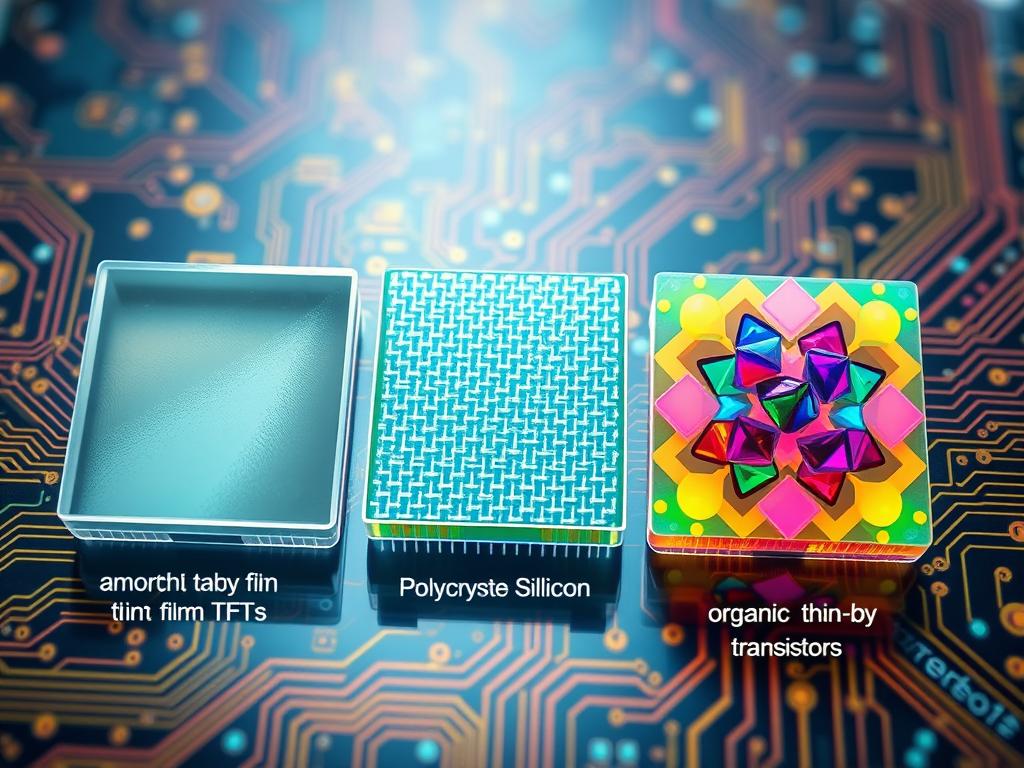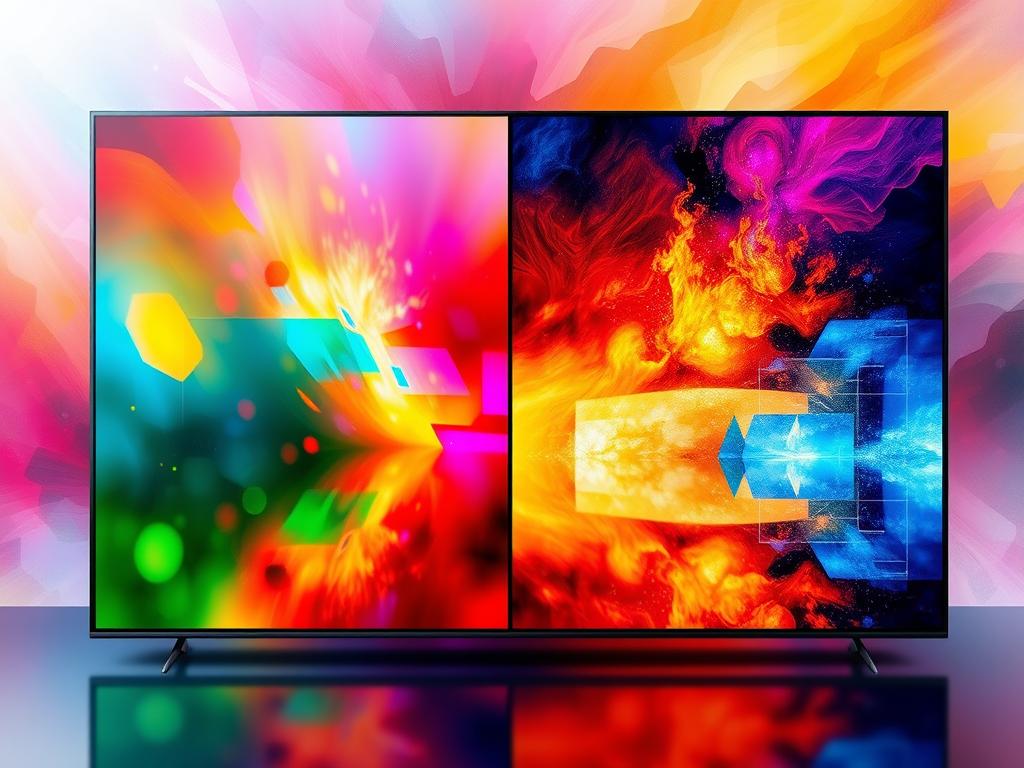Thin-film transistors (TFTs) have changed the world of electronics, especially in display technology. They are made by putting thin layers of semiconductor, dielectric, and metal on a non-conducting base. This is different from traditional MOSFETs, where the base is the semiconductor itself.
TFTs are key in today’s electronic displays, like LCDs and OLEDs. They help improve image quality and cut down power use. This makes them vital for devices like smartphones, tablets, TVs, and computer screens.
Key Takeaways
- Thin-film transistors (TFTs) are specialized semiconductor devices that enable active-matrix addressing in electronic displays, improving image quality and reducing power consumption.
- TFTs are made by depositing thin films of semiconductor, dielectric, and metallic materials on a non-conducting substrate, unlike traditional MOSFETs.
- TFTs have become crucial components in modern LCD and OLED display technologies, driving their widespread adoption in a variety of electronic devices.
- The unique properties of TFTs, such as flexibility and transparency, have also led to their use in emerging applications like wearable electronics and flexible displays.
- Advances in TFT technology, including the development of new semiconductor materials and manufacturing processes, continue to expand the capabilities and applications of these versatile devices.
Overview of Thin-Film Transistors (TFTs)
Thin-Film Transistors (TFTs) are key in the world of electronics. They are used in many devices. These transistors have a thin layer of semiconductor material on an insulating base. They have source, drain, and gate electrodes.
The start of TFT technology is thanks to Paul K. Weimer at RCA Laboratories in 1962. He made the first TFT using polycrystalline cadmium sulfide.
Definition and Fundamentals
TFTs are a special kind of field-effect transistor (FET). They work by controlling current flow with a voltage on the gate electrode. This makes them useful for amplifying signals, switching, or as logic gates in circuits.
History of TFT Development
- In the 1970s, using crystalline silicon in TFTs was a big step forward. It helped improve display technology.
- In 1979, a breakthrough came with amorphous silicon (a-Si) TFTs at the University of Dundee. This changed the field a lot.
- The first product using TFTs, the Epson ET-10 color LCD pocket TV, was released in 1984. It was a big moment for TFT technology.
- Since then, TFTs have become crucial in display technology. They help control pixels in LCD and OLED displays.
TFT technology has grown thanks to new materials, manufacturing methods, and designs. This meets the growing needs of the electronics world.
Types of Thin-Film Transistors
In the world of thin-film transistors (TFTs), several types have emerged. Each has its own special features and uses. The most well-known are amorphous silicon TFTs (a-Si TFTs), polycrystalline silicon TFTs (poly-Si TFTs), and organic TFTs. These transistors are used in many electronic devices and displays.
Amorphous Silicon TFTs
Amorphous silicon TFTs, or a-Si TFTs, are made at low temperatures and work well over large areas. But, they move charge slower than others. Their mobility is 0.5–1 cm²/Vs for electrons and about 10^-2 cm²/Vs for holes. Still, they’re popular in LCDs because they’re cheap and easy to make in big batches.
Polycrystalline Silicon TFTs
Polycrystalline silicon TFTs, or poly-Si TFTs, move charge faster and last longer than a-Si TFTs. They can move up to 4.7 cm²/Vs, great for fast applications. But, making them needs higher temperatures, which can be a problem for flexible screens and costs more.
Organic TFTs
Organic TFTs (OTFTs) use organic materials instead of silicon. They’re cheap, flexible, and easy to make in big batches. While they’re not as good as silicon-based ones yet, research is making them better.
Each type of TFT has its own strengths and weaknesses. The right one depends on what the device needs, like how fast it should work, how much it should cost, and how it’s made.

Materials Used in TFT Technology
Thin-film transistors (TFTs) are key in today’s electronics. They help improve display tech, imaging, and many devices. The materials used in TFTs affect their performance, cost, and uses.
Key Semiconductor Materials
The semiconductor layer is vital in TFTs. Researchers have looked at many materials to improve it. Amorphous silicon, polycrystalline silicon, metal oxides like IGZO, and organic semiconductors are common. Each has its own benefits and challenges, shaping the TFT’s performance and uses.
Substrate Options
Substrates can be rigid or flexible. Rigid ones, like glass or silicon, are stable and common in displays. Flexible ones, such as polyimide and PET, are used for wearable and foldable tech.
Conductive Materials
The electrodes, made from conductive materials, are crucial. Metals like aluminum and gold, and transparent conductors like ITO, are often used. The choice affects the TFT’s performance, with factors like conductivity and transparency being key.
| Material | Key Properties | Applications |
|---|---|---|
| Amorphous Silicon | Low cost, ease of deposition, low electron mobility | LCD displays, electronic devices |
| Polycrystalline Silicon | Higher electron mobility, more complex manufacturing | High-performance displays, integrated circuits |
| Metal Oxides (e.g., IGZO) | High electron mobility, low-temperature processing | High-resolution displays, flexible electronics |
| Organic Semiconductors | Potential for low-cost, flexible, and printable electronics | Flexible displays, wearable devices |
The choice of materials in TFTs impacts performance, manufacturing, and applications. Ongoing research is vital for electronics and display tech advancements.
Recent Advances in TFT Technology
Thin-film transistors (TFTs) have seen big improvements lately. These changes come from better manufacturing, enhanced performance, and flexible technology. These advancements open up new uses for TFTs in fields like displays and wearable tech.
Innovations in Manufacturing Processes
Scientists have found ways to make TFTs at lower temperatures, especially for flexible materials. This makes it cheaper to use polymer materials and integrate TFTs with flexible electronics. New methods like inkjet printing and spin-coating are also being used. They make making TFTs easier than old vacuum-based methods.
Improved Performance Metrics
There’s been a lot of work to make TFTs better. This includes improving how fast they work, how much power they use, and how long they last. New materials like indium-gallium-zinc oxide (IGZO) have made TFTs faster. This is great for displays that need to work well.
Also, making flexible TFTs that can bend and roll has been a big focus. This research is helping make electronic devices that can be folded or rolled up.
Flexible TFT Technology
Flexible TFT tech has changed the game. It lets us make displays and electronics that can bend and roll. Organic field-effect transistors (OFETs) are leading the way in this area. They’re being used in things like OLEDs, OPVs, and sensors.
Researchers are working hard to make these flexible devices even better. They want to make them last longer and work better under strain.
These advances in TFT tech are leading to a future with more flexible, efficient, and powerful electronics. This will change how we use and interact with digital devices.
| Metric | Improvement |
|---|---|
| Carrier Mobility | Increased through the use of advanced semiconductor materials like IGZO |
| Power Consumption | Reduced through efficient pixel control and backlight management |
| Stability | Enhanced through strategies to improve the strain-tolerance of flexible TFT circuits |

“The development of flexible TFT technology has been a game-changer, enabling the creation of bendable and rollable displays, wearable electronics, and conformable sensors.”
Applications of Thin-Film Transistors
Thin-film transistors (TFTs) are now key in many electronic fields. They change how we use digital devices. These semiconductors are used in display technology, imaging, and more.
Display Technology
TFTs are vital in display tech. They help make LCD, OLED, and LED screens work. New TFT tech has led to better displays like transparent and high-resolution ones.
Imaging Systems
TFTs are also crucial in imaging. They improve digital X-ray detectors and medical imaging. This boosts the quality of medical images.
Electronic Devices
TFTs are used in many devices. They power e-paper displays and touch panels. They also help make circuits for various electronic needs.
| TFT Application | Key Advancements | Potential Impact |
|---|---|---|
| Display Technology |
| Improved image quality, energy efficiency, and user experience in various electronic devices |
| Imaging Systems |
| Advancements in medical diagnostics and patient care |
| Electronic Devices |
| Improved functionality, efficiency, and integration in a wide range of electronic products |
“TFT technology has revolutionized the way we interact with digital devices, enabling advancements in display quality, imaging capabilities, and overall electronic device performance.”
TFTs in Display Technologies
Thin-film transistors (TFTs) are key in LCD (TFT-LCD) and OLED (AMOLED) displays. They boost the quality and performance of displays. In LCDs, they control each pixel. In AMOLEDs, they manage the current to each OLED pixel.
TFTs make displays better by improving response time, contrast, and color. This is a big step up from passive-matrix displays.
LCD vs. OLED Displays
Choosing between TFT-LCD and AMOLED depends on what you need. TFT-LCDs are affordable, have wide viewing angles, and are bright. They’re used in many places.
AMOLEDs, however, have better contrast, faster response, and use less power. They’re great for high-end phones and TVs.
The Role of TFTs in Enhancing Display Quality
TFTs are crucial for better display performance. They allow for active-matrix addressing. This means each pixel can be controlled individually.
This leads to better contrast, color, and response time. TFTs also help make displays high-resolution, low-power, and flexible. This opens up new uses, from phones to TVs.
| Display Technology | Advantages | Disadvantages |
|---|---|---|
| TFT-LCD |
|
|
| AMOLED |
|
|
In summary, TFTs are vital in LCD and OLED displays. They improve performance through active-matrix addressing. The choice between them depends on what you need and want.

The Impact of TFTs on Electronics
Thin-film transistors (TFTs) have changed the game in consumer electronics. They’ve led to big leaps in display tech and how portable devices work. These devices are key in making many electronic items better, like smartphones, tablets, TVs, and wearables.
Enhancing Performance in Consumer Electronics
TFTs have been a big deal for consumer electronics. They help make displays thinner, use less energy, and look better. TFTs have made it possible to have high-resolution, touch screens that use less power. This has helped smartphones, tablets, and other portable devices get better fast.
Applications in Mobile Devices
In mobile tech, TFTs have been key in making smartphones and tablets better. They help make displays that are high quality and use less power. This makes mobile devices work better, last longer, and feel more natural to use.
The effect of TFTs on electronics and mobile tech is clear. As we want more advanced, energy-saving, and portable devices, TFTs will keep playing a big part in the future.
“TFTs have revolutionized the way we interact with and consume electronic devices, paving the way for a more immersive and efficient user experience.”
Emerging Applications of TFTs
Thin-film transistors (TFTs) are changing the game in modern technology. They’re used in wearable devices, smart home systems, and car displays. These innovations are shaping the future of electronics.
Wearable Technologies
TFTs are perfect for wearable devices because they’re flexible and use little power. Smartwatches and fitness trackers use TFTs for displays and sensors. This makes them fit well into our daily lives.
Smart Home Devices
TFTs are key in smart home devices. They power touch-sensitive panels and displays in appliances and lights. This makes controlling our homes easier and more intuitive.
Automotive Displays
The car industry loves TFTs for dashboard displays, infotainment systems, and heads-up displays. They offer clear images and easy controls. This makes driving safer and more enjoyable.
TFTs are changing many industries. They’re used in wearables, smart homes, and cars. This shows how versatile and important TFTs are for the future.
Challenges Faced by TFT Technology
Thin-film transistors (TFTs) are getting better and finding new uses. But, they face many challenges. Transparent oxide semiconductors could be used in many fields. Yet, finding good p-type oxide semiconductors is hard. This makes it tough to make more complex and energy-saving devices.
Another big issue is the cost of making TFTs. Making large TFT devices, especially flexible ones, is expensive. This makes it hard for them to be used in many places. Overcoming these problems is key to making TFT technology more useful.
Limitations in Current Materials
Researchers are working hard to make better p-type oxide TFTs. This could change electronics and our daily lives a lot. Copper oxide and tin oxide TFTs are showing promise. But, they need to be more stable and work better.
Economic Factors Related to Production
It’s hard and expensive to make lots of TFT devices, especially flexible ones. Companies face problems like finding materials and making things consistently. Finding a balance is important to make TFT technology more available.
“The development of high-performance p-type oxide TFTs could lead to significant advancements in transparent electronics and impact various aspects of daily life.”
Future Trends in TFT Development
Thin-film transistor (TFT) technology is getting better, thanks to new research and industry efforts. They’re looking into advanced semiconductor materials. These could make devices work better, be more flexible, and use less energy.
Potential for Advanced Materials
The industry is moving beyond traditional silicon-based TFTs. Metal oxide semiconductors like indium gallium zinc oxide (IGZO) and tin oxide (SnO2) are being explored. They offer higher electron mobility, better transparency, and more.
These materials could lead to thinner, more flexible, and energy-saving devices. This opens up new possibilities for wearables, foldable electronics, and smart home tech.
Integration with IoT Devices
The Internet of Things (IoT) is growing fast, and TFTs will play a big role. They’ll power smart sensors, low-power displays, and communication tech for IoT. TFT-based devices will make data exchange smoother, improve user experiences, and save energy in many areas.
There’s also a big push for flexible and wearable electronics. Researchers are working on making TFTs more flexible and durable. This could lead to new uses in wearables, foldable phones, and other cutting-edge devices.
| Key Trends in TFT Development | Potential Impact |
|---|---|
| Advancements in semiconductor materials | Improved performance, flexibility, and energy efficiency |
| Integration with IoT devices | Seamless data exchange, enhanced user experiences, and improved energy efficiency |
| Enhancing flexibility and durability | Integration into wearables, foldable electronics, and other innovative devices |
The TFT industry is set for exciting changes. We can expect better materials, manufacturing, and integration with new tech. These advancements will make devices more efficient, versatile, and connected.

“The integration of TFT-based devices with IoT platforms will enable seamless data exchange, enhanced user experiences, and improved energy efficiency in a wide range of applications, from industrial automation to smart home systems.”
Environmental Considerations in TFT Production
The electronics world is changing fast, and so is the impact of thin-film transistor (TFT) technology on the environment. Companies are working hard to make their manufacturing greener. They want to make sure TFT devices can be recycled to reduce e-waste.
Sustainable Manufacturing Practices
Reducing energy use and waste in making TFTs is a big goal. Scientists are looking into new ways to use less material and cut down on chemical waste. They also aim to make the process more energy-efficient. They’re studying how TFTs fail to find ways to make them last longer and work better.
Recycling TFTs and E-Waste Management
It’s also important to recycle TFT-containing devices when they’re no longer needed. Companies are trying to make electronics that are easier to take apart and reuse. This helps cut down on e-waste and its harm to the environment.
There’s also a push to use biodegradable and eco-friendly materials in making TFTs. This approach aims to make the whole electronics world more sustainable and eco-friendly. It’s all about reducing the environmental harm caused by TFT technology.
TFTs and Their Role in the Internet of Things (IoT)
Thin-film transistors (TFTs) are key to the Internet of Things (IoT) growth. They power smart sensors, actuators, and communication tech. These are vital for IoT to work well.
Smart Sensors and Actuators
TFTs help make flexible sensor arrays for IoT devices. They use materials like amorphous silicon and indium-gallium-zinc oxide. This makes smart sensors that are very sensitive and quick to respond.
Communication Technologies
TFTs also power communication tech in IoT. They combine display, sensing, and data transmission in small, energy-saving devices. This is crucial for IoT communication in today’s connected world.
| Semiconductor Material | Charge Carrier Mobility (cm^2 V^−1 s^−1) |
|---|---|
| Amorphous Silicon (a-Si) | 0.5 – 1 |
| Indium-Gallium-Zinc Oxide (IGZO) | More than 10 |
| Low-Temperature Polycrystalline Silicon (LTPS) | More than 50 (p-type), More than 100 (n-type) |
As TFT technology advances, it will be even more important for IoT. It will help integrate sensing, control, and communication in the IoT world.
“TFT technologies are evolving towards scalable solutions with high-density flexible circuits, enabling high-performance electronic circuits suitable for various applications in the Internet of Things (IoT) industry.”

Regulatory Standards and Guidelines for TFTs
The making and use of thin-film transistors (TFTs) follow strict rules. These rules make sure TFT products are safe and meet quality standards. It’s key for makers and users to follow these rules to keep up with TFT regulations, safety standards, and industry compliance.
Compliance and Safety Regulations
TFT devices must follow strict electronic safety rules and environmental standards. Makers must use safe materials, be energy-efficient, and meet electromagnetic standards. These rules help avoid risks and make sure TFT products work safely.
Industry Certifications
Getting industry certifications is vital for proving TFT products’ quality and reliability. These certifications come from trusted groups, showing they meet safety standards and industry compliance rules.
- Common certifications for TFT devices cover things like electromagnetic compatibility (EMC), energy use, and material safety.
- These certifications make sure TFT products meet important criteria for their use.
- Following these certifications is often needed to sell products, showing they follow TFT regulations and best practices.
By following these rules and certifications, TFT makers can gain trust, improve product reliability, and ensure their technology is used safely and responsibly.
Case Studies of Successful TFT Applications
Thin-Film Transistors (TFTs) are key in many fields, like consumer electronics and medical imaging. They show how versatile and impactful TFTs are. These examples show how TFTs have changed the game in different areas.
Real-World Implementation in Consumer Electronics
In consumer electronics, TFTs have greatly improved display quality. For example, high-resolution OLED displays in top smartphones use TFTs. This gives them bright colors and deep blacks.
Also, big OLED TVs use TFTs for their thin, light, and energy-saving design. This has changed how we watch TV at home.
Breakthroughs in Medical Imaging
In medical imaging, TFTs have made a big difference. They’ve replaced old film systems with flat-panel X-ray detectors. These new detectors give better images, use less radiation, and are more comfortable for patients.
TFTs are also used in newer imaging like digital mammography and CT scanners. Their ability to capture clear images helps doctors find and treat diseases early.
| TFT Application | Semiconductor Material | Advantages |
|---|---|---|
| Smartphone Displays | Metal Oxides | High charge carrier mobility, uniformity, and stability |
| OLED TVs | Polycrystalline Silicon | High charge carrier mobility, low leakage current, and thermal stability |
| Digital Radiography | Amorphous Silicon | Low cost, large-area deposition, and high ON/OFF ratio |
These examples show how TFT case studies have changed consumer electronics and medical imaging. As TFT technology gets better, we’ll see even more amazing uses in the future.
Conclusion: The Future of Thin-Film Transistors
The electronics world is always changing, and thin-film transistors (TFTs) are at the forefront. There’s a big need for flexible, clear, and power-saving electronics. This need is pushing TFT tech to new heights.
Scientists and manufacturers are working hard to improve TFTs. They’re exploring new materials and ways to make them. This will help TFTs become even more useful in many fields.
Forecasting Market Trends
The TFT market is growing fast. This is because of the rise in advanced displays, wearable tech, and the Internet of Things (IoT). New uses in healthcare, cars, and smart homes will also boost demand.
The Ongoing Evolution of TFT Technology
TFT tech is getting better all the time. New materials and better ways to make them are improving performance. This means TFTs will soon be in many devices, from screens to sensors.
The future of TFTs looks very bright. They will help us interact with the digital world in new ways. The ongoing work on TFTs will be key in shaping the future of electronics.


